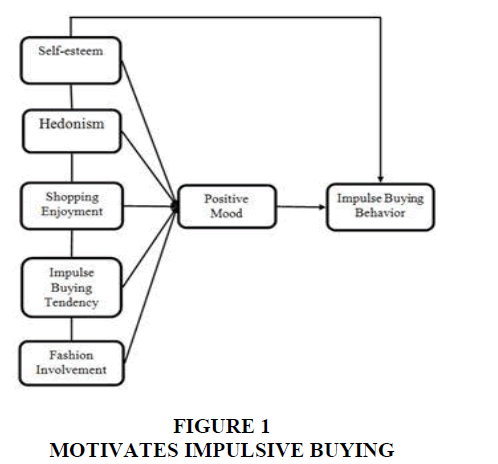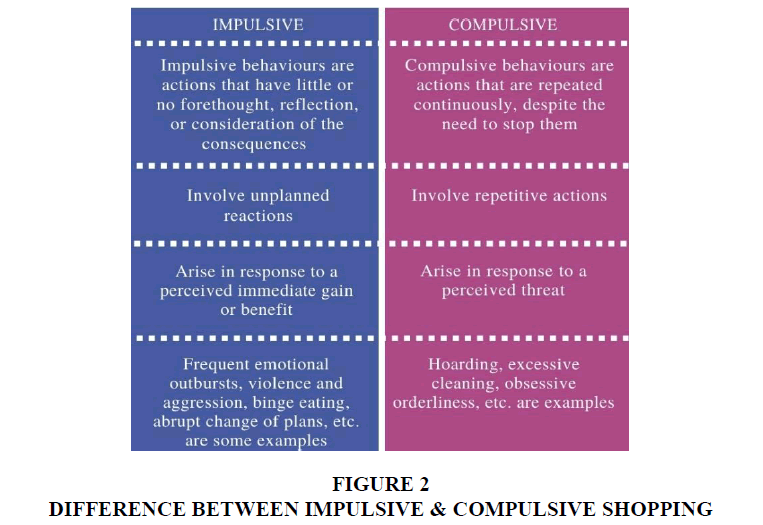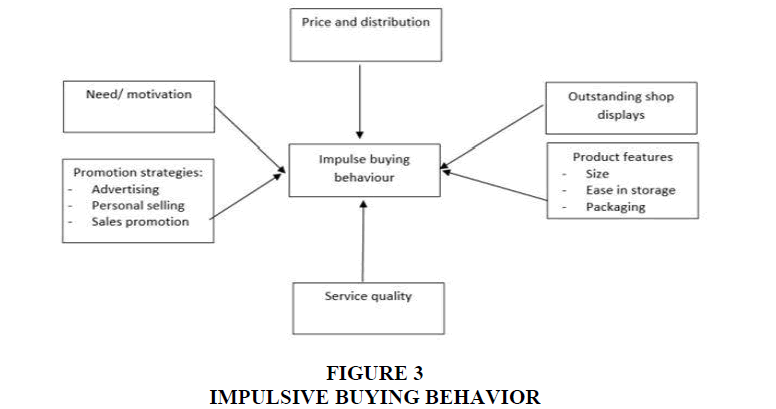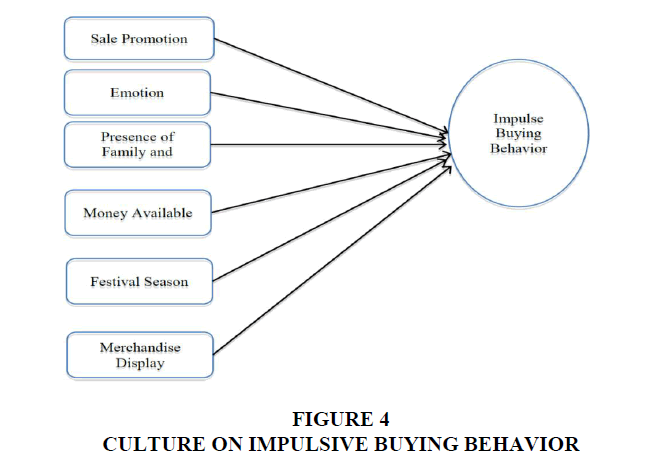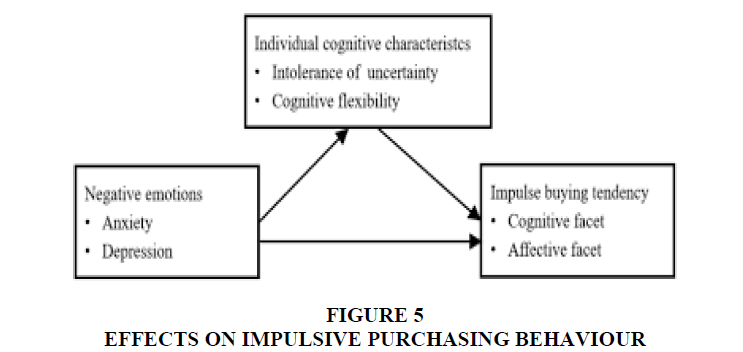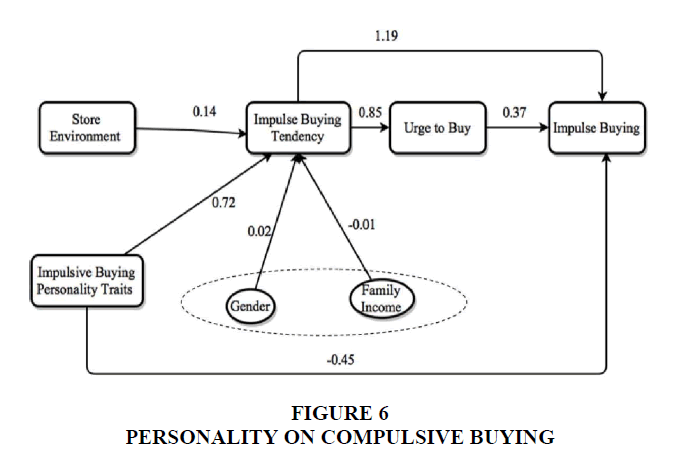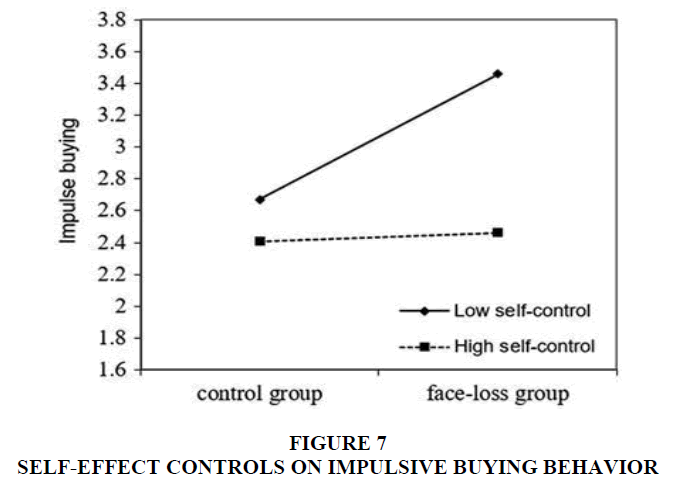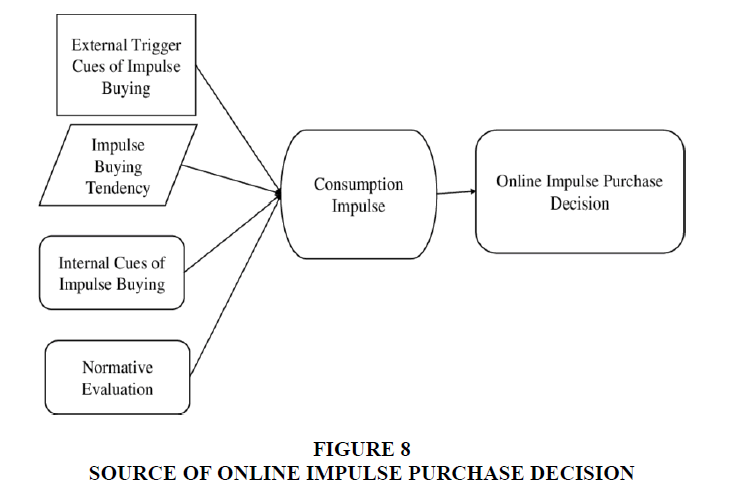Research Article: 2023 Vol: 22 Issue: 3
Impulsive Buying Behavior of Enterprises towards Costumers
Huda Mabkhoot, Imam Abdulrahman Bin Faisal University
Eman Almutairi, Imam Abdulrahman Bin Faisal University
Refa Alhajri, Imam Abdulrahman Bin Faisal University
Mahmood Maqsood, University of Bahrain
Hoda Mahmoud AboAlsmh, Imam Abdulrahman Bin Faisal University
Ibrahim Tawfeeq Alsedrah, Imam Abdulrahman Bin Faisal University
Zahra Afridi, Imam Abdulrahman Bin Faisal University
Citation Information: Mabkhoot, H., Almutairi, E., Alhajri, R., Maqsood, M., AboAlsmh, H.M., Alsedrah, I.T., & Afridi, Z. (2023). Impulsive buying behavior of enterprises towards costumers. Academy of Strategic Management Journal,
22(S3), 1-13.
Abstract
All of us have, at some point, engaged in the behaviour of impulse buying. Unplanned purchases made by consumers on the spur of the moment are a significant aspect of their purchasing behaviour. We frequently experience strong internal urges or temptations to buy certain things, to the point where we make snap decisions without much thought. Impulsive behaviour is not just used by children; often, adults with rational minds exhibit it as well. Discount offers, the salesperson's demeanour, the product's display, nature, the customer's situation, the shopper's personal traits, and so on all influence a person's hasty decision to make an impulse purchase. For brick-and-mortar retailers, impulse purchases have grown to be a significant source of revenue. Marketers make every effort to capitalise on consumers' impulsive behaviour by employing all available strategies.
Keywords
Consumer Behavior, Businesses, Impulsive Buying, Impulsive Purchase.
Introduction
Consumer Behavior
Consumer behaviour is the evaluation of a person's decision to buy or not buy a product based on “when, how, why, and where.” Its goal is to investigate how consumers make decisions, whether collectively or individually (Kathiravan et al., 2019). Consumer behaviour examines behavioural and demographic factors to determine the ease with which buyers' needs can be understood. Families, friends, and society are just a few of the numerous factors that influence consumer behaviour (Rodrigues et al., 2021). Consumer purchasing trends heavily influence any organization's marketing tactics and strategies. Businesses plan their production based on consumer behaviour. When making purchases, consumers consider satisfaction and value addition. Assume that before purchasing a mobile device, a person considers various features such as the applications it supports, the built-in and expandable memory, the sound and picture quality, camera pixels and resolutions, single SIM or dual SIM, and so on. He also draws parallels between the product and that of the competitor. Businesses must concentrate on customer behaviour if they want to increase sales (Yang et al., 2021).
Impulsive Buying
An impulsive purchase is one that is made without much thought or planning. In other words, impulsive shopping is defined as a sudden decision to purchase any good or service. With the help of a variety of in-store influencers, retailers are attempting to convert browsers into buyers (Husnain et al., 2019). Consumer research has been conducted since the 1950s to better understand the concept of impulsive buying. Unplanned purchases made as a result of an external trigger, such as seeing the desired item in a store, are referred to as impulsive purchases. Impulsive buying is motivated internally. Highly impulsive buyers are likely to act without thinking things through, be emotionally drawn to the item, and want instant gratification. These consumers frequently give little thought to any possible negative effects of their behaviour.
The DuPont Consumer Habits Studies, sponsored by the Point-of-Purchase Advertising Institute from the 1940s to the 1960s, and by Patterson in the 1960s, were among the earliest studies on impulse buying (Ming et al., 2021). These studies examined a variety of countries and discovered that American shoppers are more impulsive than those in other countries. Approximately 80% of people make impulsive purchases in some categories. The development of new technologies such as 24-hour convenience stores and marketing innovations may lead to an increase in impulsive purchasing. The high levels of convenience and accessibility provided by these technologies also contribute to the rise in impulsive purchasing.
What Motivates Impulsive Buying
Our consumer culture encourages people to give in to temptation and make hasty purchases, which is a psychological phenomenon. Impulsive buying needs to be psychologically controlled because it has been connected to depression and anxiety. It is possible to connect a person's propensity for impulsive purchases to personality traits that make them habit-forming. Impulsive buyers are frequently social creatures who attach great importance to their reputation and social standing. People make impulsive purchases in order to look good and impress others so that others will think well of them. Consumers frequently make impulsive purchases in an attempt to improve their mood. Impulsive shoppers are unconcerned about the consequences of their actions. In addition to all of this, cost is an issue. Many people make rash purchases because something is on sale. Stock clearances and special offers for premium customers also encourage impulse purchases Figure 1.
Problem Statement
Consumer behaviour is a difficult philosophical issue because everyone thinks differently. A variety of factors discussed in marketing and human psychology literature influence customers' impulsive purchase decisions Figure 8. A number of experts, academics, and marketers have labelled impulsive buying as “abnormal” or “irrational.” It's been fascinating and challenging to comprehend the reasons and circumstances that lead people to make impulsive purchases because they deviate from the norm. To increase sales and customer loyalty, retailers and marketers may employ a variety of strategies to influence this type of behaviour. The simplest definition of impulse buying is “the customer behaviour or proclivity to acquire specific products without a prior strategy” (Choudhary, 2014).
Research Question
1. How did impulsive buying affect businesses' interactions with customers?
2. How did businesses respond to the digital revolution's impulsive consumer behaviour?
3. How fast is impulsive shopping growing?
4. What advantages do modern businesses stand to gain?
5. Is there anything that could be improved to help the business grow?
Research Objective
The purpose of this research is to determine how a company's environment influences its customers' proclivity to make impulsive purchases. In business, the concept of “survival of the fittest” is at its peak, and companies are under pressure to position them as desirable as possible. In addition to product attributes and price, the majority of brand-conscious consumers are drawn to the atmosphere of retail establishments. In order to determine the impact of this behaviour, the current study examined how one specific aspect (impulse-buying propensity) interacted with four stores ambient factors-music, light, layout, and employees. This study was conducted in a setting where previous studies had not been conducted, using data collected from Saudi Arabian shopping malls, and a hub for a diverse range of shoppers. Survival is becoming a major concern for company leaders and marketers as the business world becomes more competitive and companies operate on razor-thin margins.
Significant of Study
It's been fascinating and challenging to comprehend the reasons and circumstances that lead people to make impulsive purchases because they deviate from the norm. To increase sales and customer loyalty, retailers and marketers may employ a variety of strategies to influence this type of behaviour. The simplest definition of impulse buying is “the customer behaviour or proclivity to acquire specific products without a prior strategy.”
Literature Review
Difference between Impulsive & Compulsive Shopping
There are two types of shopping: compulsive shopping and impulsive shopping. Consider these two purchasing habits to be brain-controlled behavioural patterns. The following characteristics distinguish the two: In contrast to compulsive shopping, which is repetitive in nature, carried out in accordance with predetermined rules, and is more of a stereotype, impulsive buying is defined as purchases that are hastily made and expressed prematurely. One example of impulsive behaviour that isn't always unintentional is gambling. Compulsive shopping is associated with repetitive, rule-following behaviour that is more stereotypical in nature. In contrast to impulsive shopping, which is driven by external factors, compulsive shopping is driven by internal factors. Many psychiatric disorders, including cluster B personality disorders, impulse control disorders, and bipolar disorder, have impulsive behaviors as core symptoms. Negative effects like financial hardships, family strife, and emotional disarray can result from compulsive behaviour. Compulsiveness seems to be more correlated with higher frontal lobe activity, whereas impulsivity seems to be more correlated with lower frontal lobe activity. Impulsive buyers initially feel happy, but that happiness eventually fades. It can be said that compulsive shopping is typically done to relieve anxiety or pain, whereas impulsive shopping is typically done to find pleasure or satisfaction. While impulsive buying is positively associated with online shopping, compulsive buying can be positively associated with offline shopping Figure 2.
Personal Characteristics Contributing to Impulsive Buying
Individual shopping habits differ from one another. However, there are some psychological factors that are responsible for impulsive purchasing and are shared by all. These psychological factors include the following:
Emotions
Emotions are important in impulsive shopping. Shopkeepers are well aware of this and have hit on a sensitive point. Children are a very vulnerable target and are easily enticed. Shopping helps buyers overcome insecurity and gives them a sense of completion.
Shopping is becoming an addiction as a result of the shifting social landscape. For themselves and their families, people want the newest items. Social media is promoting shopping by letting people know about the newest trends and offers, which is causing it to become an addiction.
Stress
Many people believe that going shopping will make them happy, but they are unaware that this pleasure is fleeting and will diminish over time. When consumers shop impulsively, they believe that it will relieve stress, but once they get home, they feel bad and begin to regret their choices.
Age is an important factor that influences impulsive shopping. Younger shoppers have been found to be more impulsive than older shoppers. However, such a trend is not visible in developing countries such as Pakistan, where the younger generation is heavily reliant on their families due to a lack of independent sources of income.
Gender
Gender has a significant impact on impulsive purchasing. Some studies show that women are more likely than men to make impulsive purchases. According to other research, men are more impulsive than women because women carefully consider their purchases.
Income
Those with a high disposable income are more likely to buy impulsively than those with a low disposable income. Individualism and collectivism are two societal values. The dimension of culture is the most important cultural factor relating to the problem of impulse buying. Individuals who adhere to the individualism model regard themselves as autonomous, whereas those who adhere to the collectivism model regard themselves as a part of the group. An independent person has more freedom and liberty than someone who is constrained by a group of people, such as friends or family, which may influence impulsive buying.
Uncontrollable budget
Shopping on the spur of the moment is done without consideration or planning. Many people make rash purchases that they later come to regret. Shopping on the spur of the moment devastates budgets and diverts funds away from items that aren't very useful.
Wrong Decisions
When people shop normally, they carefully consider the quality and features of each good or service before purchasing, but when they buy something on the spur of the moment, they don't give it much thought. Consumers frequently purchase goods or products without haggling or evaluating them, only to later regret not using the money Figure 3.
Impulsive shopping is the source of a buyer's irrational behavior. Impulsive buying gradually impairs rational thought and reasoning skills, which are expected of all buyers. Customers gradually begin to trust people more readily as a result of impulsive thinking and are frequently taken advantage of by others.
How to Avoid Impulsive Shopping
• Planning your shopping will help you stay within your spending limit.
• A list of essential items must be created, and the buyer must only follow it.
• Shop window displays are too alluring; one should resist these temptations.
• Parents should not accompany children who are easy targets while shopping.
Impact of Culture on Impulsive Buying Behavior
The cultural dimensions of collectivism/individualism have received the most attention. The individualism-collectivism construction exemplifies the contrast between common cultural orientations that value the individual and those that value group harmony. Individualistic societies are “I” oriented, whereas collectivist societies are “we” oriented. Individualism refers to societies in which People prefer independent emotional relationships and put personal goals above their own group, while collectivism refers to the interdependence of members of the public, consisting of people who see themselves as an inseparable part of one or more groups Figure 4.
Negative Emotions' Effects on Impulsive Purchasing Behaviour
Feelings of despair, anxiety, melancholy, or depression are linked to negative emotions. These conditions or responses show up as adverse responses to one's health, situations, and environmental experiences. Context influences negative feelings. An effective way to combat unpleasant emotional states, such as anger, is through chronic, high-frequency impulse purchase that is characterized by obsessive traits. B. To avoid or lessen negative emotions, repression and poor self-esteem are used. Negative emotions like B can be diluted and lead to impulsive purchase. Attempting to find happiness. Customers are more likely to make impulsive purchases to get rid of bad feelings because of the broad selection of goods available on e-commerce buying platforms Figure 5.
Influence of Personality on Compulsive Buying
The Big Five model is a hierarchical description of personality traits, with five major components serving as the most abstract representation of personality. This model is an important tool for distinguishing personality traits. Another important component is the consumer's personality, which determines how they make decisions. As a result, the relationship between personality and consumer behaviour has piqued the curiosity of many academics. The Big Five Model's five personality structures, extraversion, neuroticism, agreeableness, conscientiousness, and openness, were investigated for any potential links to impulsive purchase Figure 6.
Self-Effect Controls on Impulsive Buying Behavior
Self-control is often regarded as a sign of willpower, which is the resolve to resist a particular need. The availability of contextual costs and advantages as well as the individual's long-term values connected to the desire are frequently viewed as influencing factors in the definition of impulsive purchase increase. Examining mesolimbic activity, consumer awareness, signals, and (lack of) self-control might help predict impulsive behaviour. Self-control variations between people are innate and are an unchanging aspect of personality. Now, self-control can be seen as a resource. A “force” or “limited resources” model of self-control has been put forth by certain academics, in which self-control is viewed as a finite resource Figure 7 and Figure 8.
Hypothesis
H1: Collectivism has a positive direct effect on impulsive buying behaviour.
H2: Negative emotions have a direct, favourable influence on impulsive purchasing behaviour.
H3: The extroversion of the big-five model has a positive impact on impulsive buying.
H3a: Ness, the outgoing member of the Big Five, has a direct impact on impulsive buying.
H3b: The extroversion of the big-five model has a favourable indirect impact on impulsive buying behaviour through collectivism.
H4: The neuroticism of the big-five model has a positive impact on impulsive buying.
H4a: The neuroticism of the big-five model has a direct impact on impulsive buying.
H4b: Through negative emotions, the neuroticism of the big-five model drives impulsive buying.
Methodology
Data Collection
Traditional brick-and-mortar stores are rapidly being replaced by online retailers as a result of the Internet's rapid expansion, and the number of online shoppers grows yearly. Therefore, online consumer groups-more especially, customers of well-known Chinese e-commerce platforms like Taobao and Tall-are the studies target audience. We were able to carry out our online poll because to the significant user bases these electronic commerce platforms have. Meanwhile, an offline survey is no longer advised due to the COVID-19 outbreak's effects. Data collection online is therefore significantly safer. Additionally, an online survey's convenience sometimes results in higher response rates and fewer incomplete responses.
Measures
We employed two scores to assess the behaviour of impulse buyers. Adjusted scales for the Big Five model's measures of neuroticism and extraversion. Based on are the negative emotion scales. Additionally modified from earlier studies are the collectivism scales. Based on this, the self-control scales are changed. We combined various studies to create scores that assess the propensity for impulsive purchases.
Research Methods
We used Structural Equation Modelling (SEM) as the analytical approach to precisely assess the hypotheses because there are numerous complicated hypotheses across and between predictors and predictors. The evaluation of complicated hypotheses, particularly those involving networks of path interactions, is based on multivariate data. Structural equation modelling is an extension of path analysis, which enables us to investigate the relationship between observable and latent variables. It describes the relationships between processes, their relative significance, and how perturbations have an effect on the system as a whole.
Results
In this work, structural equation modelling with maximum likelihood estimation was done using SPSS 27.0. We choose a two-step procedure for structural equation modelling due to the complexity of the interactions between the many variables in our model. Prior to conducting a hypothesis test, the overall measure's reliability and validity are first estimated.
Measurement Model
Using the extracted mean variance (AVE), Cronbach's alpha, and composite reliability score (CR), we estimated measurement models Table 1. CR and Cronbach values are used to assess internal consistency and all of them are greater than 0.7 for all latent variables, suggesting strong internal consistency. We determined the AVE to ascertain convergent validity. Each AVE result above the suggested cutoff point of 0.5, demonstrating significant validity. In order to assess a construct's discriminant validity, we also employ AVE to discover whether it differed from others. For acceptable discriminant validity, each construct must have stronger correlations with its own constructs than with other constructs.
| Table 1 Measurement Models |
|||||
|---|---|---|---|---|---|
| Latent Variable | Observed Variables | Indicator Loadings | Cronbach's α | CR | AVE |
| Impulsive buying behavior | IB1 IB2 |
0.841 0.822 |
0.817 | 0.818 | 0.692 |
| Extroversion | EX1 EX2 |
0.810 0.813 |
0.794 | 0.799 | 0.666 |
| Neuroticism | NT1 NT2 |
0.853 0.836 |
0.829 | 0.833 | 0.713 |
| Negative emotions | NE1 NE2 NE3 |
0.788 0.896 0.881 |
0.888 | 0.892 | 0.733 |
| Collectivism | CO1 CO2 CO3 CO4 CO5 |
0.718 0.746 0.825 0.818 0.772 |
0.896 | 0.884 | 0.604 |
| Self-control | SC1 SC2 SC3 SC4 SC5 SC6 SC7 |
0.793 0.758 0.758 0.828 0.779 0.714 0.855 |
0.916 | 0.918 | 0.616 |
| Impulsive buying tendency | CF1 | 0.670 | 0.853 | 0.855 | 0.600 |
| (cognitive factor) | CF2 CF3 CF4 |
0.793 0.776 0.842 |
|||
| Impulsive buying tendency | AF1 | 0.797 | 0.839 | 0.841 | 0.569 |
| (affective factor) | AF2 AF3 AF4 |
0.804 0.687 0.724 |
|||
Discussion
One successful strategy for promoting sustainable consumption is overconsumption. The negative consequences of excessive consumption are commonly connected with impulsive buying since this behaviour has the potential to be detrimental to consumers' well-being as well as to society as a whole in terms of sustainability. This article explores the elements that affect consumers' impulsive online purchasing behaviour from the standpoint of customers' inherent qualities in an effort to promote responsible consumption. This study develops a theoretical framework based on consumer personality, emotion, culture, self-control, and the propensity for impulse purchases, all of which have been extensively utilised in earlier studies. The model is based on studies in the areas of psychology, consumer behaviour, and sustainability.
First, all direct impacts were confirmed, and it was discovered that the only element that actually made impulse buying in e-commerce much worse was self-control. According to this research, impulsive online shoppers are more prone to lack self-control. This outcome confirms past studies' results that self-control has a detrimental effect on generalised impulsive buying behaviour. Consumers with excellent self-control are more likely to resist temptation when exposed to diverse retail marketing strategies. The easier it is for consumers to rein in their impulsive buying behaviour, the better their self-control. Therefore, impulsive shopping tendencies can be seen as a lack of restraint. Examining the indirect effects reveals that negativity and collectivism both function as mediators. On the one hand, our study discovered that extroversion can result in impulsive buying due to its support of collectivism. Individuals with outgoing personalities are more likely to foster or activate collectivism, which increases their propensity for impulsive buying. Extrovert customers can easily fit in with a group and then be influenced by the sentiment of the group.
However, we found that while neuroticism and the affective component of impulsive purchase inclination can both promote impulsive purchasing behaviour by positively affecting negative feelings, self-control can prevent impulsive purchasing behaviour by positively affecting negative emotions. Impulsive buying can result from emotional instability, which is a trait of neuroticism and is typically accompanied by unfavourable emotions. In addition, the affective aspect of the predisposition toward impulsive buying is easily influenced by the surroundings, resulting in unfavourable feelings that may trigger impulsive behaviour. Furthermore, maintaining excellent emotional control is challenging when self-control is weakened. This makes it easier for people to feel bad emotions, which makes them more likely to make impulsive purchases.
Conclusion
This study proposes an effective marketing module to solve the issue of online impulse buying. Its underpinnings are the SOR theory module and past research. For verification, the module is included in the feature extraction network. Data experiments were carried out, and the module with the best results in the data analysis index was selected. The GFI score of 0.903 indicates that the proposed module can strengthen the hypothesis. This study innovates in two theoretical contributions. First, psychology is the genesis of the concept of social existence. This concept has piqued the interest of researchers in the fields of brand management, marketing, and communication. The discovery of the social presence characteristics of platforms and the association of impulsive purchasing behaviours are the two biggest scientific accomplishments made by this study. Previous studies on social presence mostly filled in the gaps in brand emotion research on live broadcast platforms with studies on artificial intelligence, online education, and virtual reality. This study also offers fresh perspectives for further investigation into the brand emotion of Internet material.
References
Choudhary, S. (2014). Study of impulse buying behavior of consumers. International Journal of Advance Research in Computer Science and Management Studies, 2(9), 1-4.
Husnain, M., Rehman, B., Syed, F., & Akhtar, M.W. (2019). Personal and in-store factors influencing impulse buying behavior among generation Y consumers of small cities. Business Perspectives and Research, 7(1), 92-107.
Indexed at, Google Scholar, Cross Ref
Kathiravan, C., Mahalakshmi, P., & Palanisamy, V. (2019). Online impulse buying behavior of consumer triggered by digital marketing. International Journal of Recent Technology and Engineering, 8(256), 648-652.
Indexed at, Google Scholar, Cross Ref
Ming, J., Jianqiu, Z., Bilal, M., Akram, U., & Fan, M. (2021). How social presence influences impulse buying behavior in live streaming commerce? The role of SOR theory. International Journal of Web Information Systems, 17(4), 300-320.
Indexed at, Google Scholar, Cross Ref
Rodrigues, R.I., Lopes, P., & Varela, M. (2021). Factors affecting impulse buying behavior of consumers. Frontiers in Psychology, 12, 697080.
Indexed at, Google Scholar, Cross Ref
Yang, F., Tang, J., Men, J., & Zheng, X. (2021). Consumer perceived value and impulse buying behavior on mobile commerce: The moderating effect of social influence. Journal of Retailing and Consumer Services, 63, 102683.
Indexed at, Google Scholar, Cross Ref
Received: 07-Jan-2023, Manuscript No. ASMJ-23-13097; Editor assigned: 08-Jan-2023, PreQC No. ASMJ-23-13097(PQ); Reviewed: 21-Jan-2022, QC No. ASMJ-23-13097; Revised: 30-Jan-2023, Manuscript No. ASMJ-22-12730(R); Published: 06-Feb-2023
